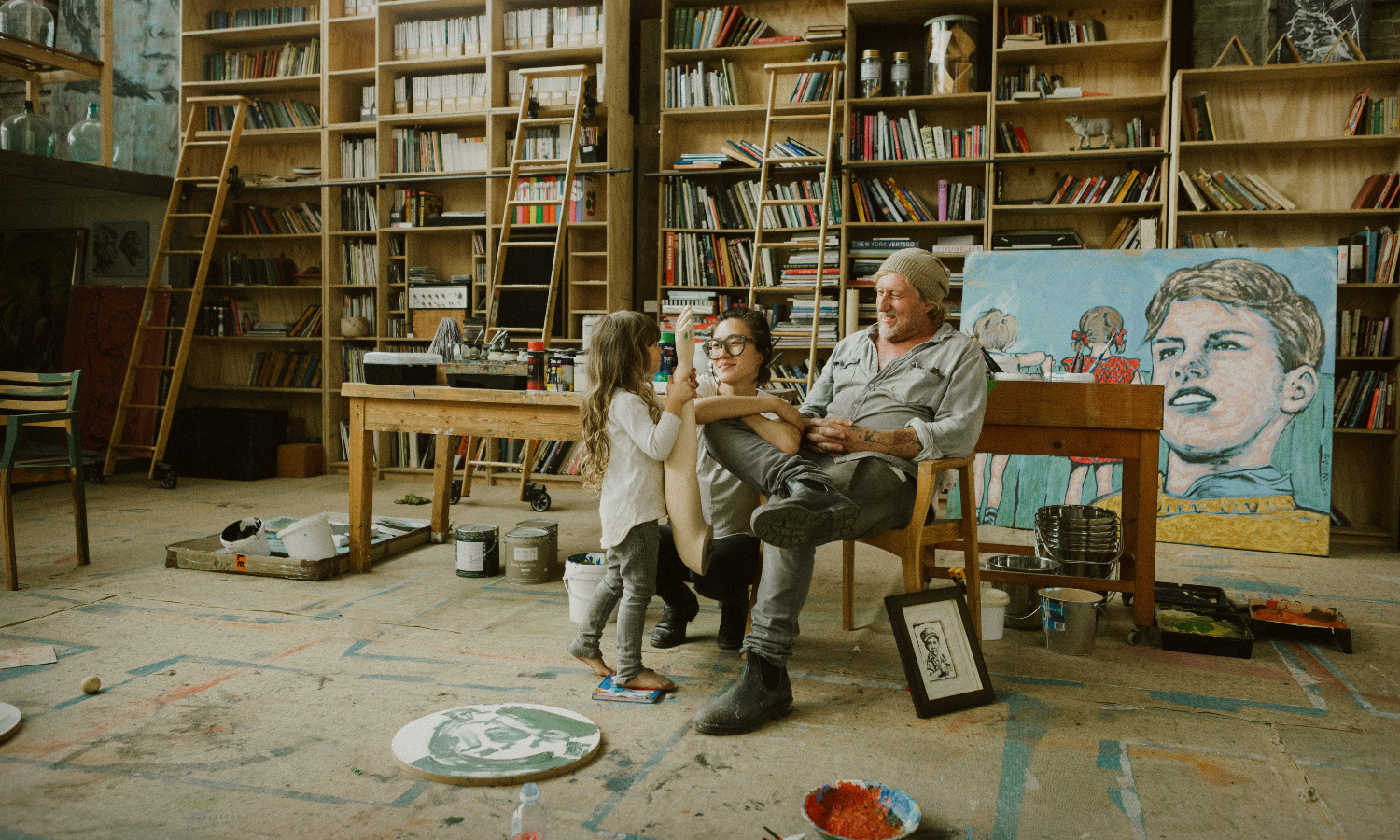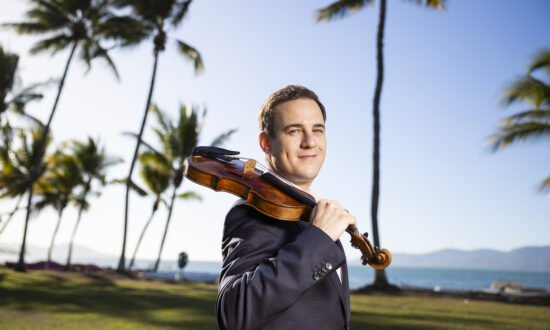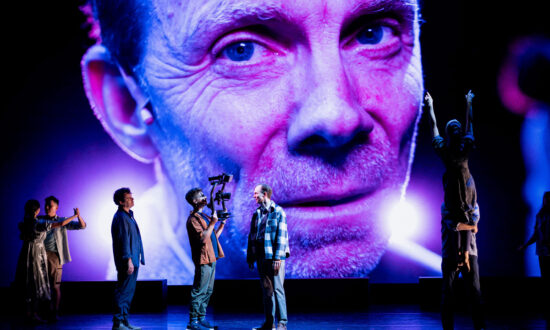David Bromley, the artist from Adelaide whose nostalgia-infused images of apple-cheeked children and stylised semi-nudes are instantly familiar, really doesn’t care what people think.
In a revealing documentary, Bromley: Light After Dark, the prevailing criticisms of his work – the prolific churning out of work that floods his own market, the similarity of themes, and his embrace of commerciality – are given their dues.
Not that he minds.
“I’ve been kicked in the head so many times and I’ve lost people I love,” Bromley, 63, says from his studio compound in Daylesford, Victoria. “I’m just a person. You lose people that you love, or you lose yourself, and you don’t care what anyone says about your art.”
One on-screen critic says Bromley’s weakness was there was nothing to find in the paintings below their surface. Another criticised the work as overproduced and unedited and the critic who compared him to pop artist, Andy Warhol, said Bromley’s ubiquity was both his triumph and his downfall.
“I don’t give a shit what people think about my art – I’m interested in what my kids think of me and my wife thinks of me,” Bromley says. “I’ve been in it too long to care. I mean I used to care. You’re just glad for what you do and you know you employ 40 people and they rely on you for their own families. People don’t know what I do and who I am.”
He knew and trusted the director, Sean McDonald, who for several years followed the painter and his wife, Yuge Yu who he married in 2013. The wild and insightful film shows the outcast artist with tattoos of ACDC’s Bon Scott and Malcolm Young who has found a modicum of peace after struggling with demons for most of his life. He works at a manic pace in his studio until 2am and has no plans to stop – although, interestingly, none of the demons make it into this work. It’s as if he paints what he does to keep them at bay.
From an early age, growing up in Adelaide where he and his brother collected and repurposed old bikes and discarded tools scavenged from the Thebarton dump, Bromley was an outsider who was terrified by how abnormal he felt.
“As my voice was breaking, so was my sanity,” Bromley says.
He says his time in Adelaide, which included stints at Middleton and Port Adelaide, was notable for being the location of his first suicide attempt, in his early 20s, which led to a spell in Glenside. He was involved with drink and drugs, as were his friends, but their careers were taking off. He was living by the beach at Glenelg north but the phobias that have plagued him throughout his life were taking hold and it was hard to see a future.
“I had such bad agoraphobia, I couldn’t drive, I couldn’t fly,” he says.
I think I’m the luckiest person alive. I mean that’s got to be success, doesn’t it?
From that rock-bottom state he went to Noosa to search for something to commit to. Being an artist was too much to imagine when his mates were plumbers and boiler makers and his brother was a fitter and turner; it seemed a fairytale to think that was what he could become.
“I was so far away from thinking I had any sort of talent or worth,” he says.
At a market one day he talked to a potter, liked what he saw and took classes and says it never felt like too big a leap, more like becoming a carpenter or a craftsman. He hoped it might save him from the endless anxiety and night terrors.
“To pot, and to go surfing was all I needed and I had more better days than I had worse,” he says.
Then he moved into painting and it opened the doors to a creative outpouring that still persists at such a rate Bromley is said to undermine the value of his own work.
There was no seminal moment that meant Bromley had arrived. He exhibits overseas, particularly in Japan and America, and there was a time when the Art Gallery of South Australia and the National Gallery bought his work. He painted a portrait of cricketer Ian Botham for the House of Lords, mixed with Bob Geldof and met David Bowie who had Bromley art in his collection. When they sold after Bowie’s death, the stardust rubbed off and the price of the works skyrocketed.
But he has never settled into a level of comfort and Bromley says he still feels as though any successes might be followed by a nervous breakdown or catastrophe.
“You know, a painting of mine the other day went for $150,000,” Bromley says. “The following day, 10 of my works will come up at auction and the bottom falls out of them.”
He still struggles with mental illness but says there is a great deal of difference between someone who is bipolar and suffers from anxiety, and someone who isn’t happy. He suffers, but not like he used to. He is also happily married with seven children, four from his previous marriage and three with Yuge whose presence seems to calm him.
His studios have always been magnificent places. In Adelaide he owned a light-filled church on Port Road with towering ceilings and walls covered in his art, easels showing half-finished paintings, sculptures and curiosities, and more paintings stacked against walls. In Daylesford, the studio is the same: flooded with light, instantly recognisable as David Bromley’s and decorated with work that looks familiar although much of it is new.
Bromley says these rich studio environments in which his children happily play are an absolute tool for him; they inspire him the way listening to music does. He grew up with parents who let him paint Rocky Horror Show in dripping red on his wall, and later used to collect driftwood for furniture. Creating special environments is the only way he can live and function.
“I’ve always loved interiors,” he says. “I’ve been in more magazines for interiors than I have for my art.”
He knows his art is decorative, even when critics deride him as an interior decorator and nothing more. None of it hurts him. He says he prizes art in his life and invests his personal ideals in family and the way he lives.
“I’ve always painted art for people’s walls,” he says. “Decorate isn’t a bad word to me. Nostalgia is not a bad word to me. Commercialism is not a bad word to me.”
One of his critics took issue with the Bromley art museum he and Yuge run in country Victoria in what was once the Castlemaine Gaol, saying Bromley had opened a museum to himself. The documentary shows he and Yuge discovering the large, forbidding property with branching corridors running off a central hub. Called the Bromley & Co. Collection Museum, it contains Bromley’s whimsical paintings and sculptures but is also a showcase for his personal art collection, and a place for newer artists to show work. Yuge says some of the work is from artists who were not recognised in their life, alongside a diverse display of Whiteleys, Blackmans, Warhols and lesser known Melbourne graffiti artists.
The space itself has a non-conforming wildness that Bromley says makes it feel like an extension of their home.
“I’ve got 100 different artists in there, it’s not a shrine to me, nothing could be further from the truth,” Bromley says with a hint of outrage. “I buy more art than most people and I keep it and it’s in the gallery. I spent four years building a thing to art, not to me. I put my stuff in there because I’m not ashamed of myself, I like myself.”
He also hopes the museum will be his legacy that he can pass down to his children who will manage it after he has gone.
His blatant commerciality seems an irritant to many, one of whom in the documentary likened him to Ken Done, the Sydney artist whose sunny, colourful daubs adorned tea towels and t shirts. Bromley, whose image of rosy-cheeked children seem to have been drawn from the Happy Little Vegemite era, lent his art to an anniversary edition Vegemite jar, and a range of Chemist Warehouse perfumes, not to mention the decorated mugs and homewares produced by Bromley &Co., often covered in butterflies. He took the invitation from Vegemite as an honour, and defends the perfume on the grounds that other creative people have done the same.
“I don’t know … I think I’m the luckiest person alive. I mean that’s got to be success, doesn’t it?” he says.
Bromley will come to the Adelaide Film Festival for the premiere but does not expect people will really know him after seeing the documentary. He says he took it on as a bit of comedy, not a serious academic study of the artist, David Bromley.
“As far as showing a certain part of myself – people talk about the art scene and what an artist’s life is like it,” Bromley says. “Well, I’m not depicting what an artist is like, I’m depicting what I’m like.”
He says he no longer cares how he fits into the art world because he has done so well, and is unbothered enough to admit that he sometimes agrees with his critics.
“As if I haven’t considered that!” he says. “And as if you’re the first person who has ever told me that!”
He is managing his phobias better but is nervous at having agreed to fly to Adelaide later this month. He says he will get on the plane, take medication, pull a beanie over his eyes, put in ear buds and turn up his playlist, starting with Motörhead and the Stones, and rely on his wife to get him safely there.
Bromley has been painting now for four decades and has been knocked down and got back up too often to care whether or not the documentary will enhance his reputation as an artist.
“I think it would make me an ungrateful fool to worry about what people say,” he says. “I’ve got a roof over my head, I’ve got a beautiful studio, a beautiful family. I couldn’t give a shit what they say.”

Get InReview in your inbox – free each Saturday. Local arts and culture – covered.
Thanks for signing up to the InReview newsletter.
Bromley: Light After Dark screens on October 20 and October 25 as part of the Adelaide Film Festival.
To get help 24/7, phone Lifeline on 13 11 14 or the Suicide Call Back Service on 1300 659 467. If you or someone you know are in immediate danger, phone 000 for emergency services.
Support local arts journalism
Your support will help us continue the important work of InReview in publishing free professional journalism that celebrates, interrogates and amplifies arts and culture in South Australia.
Donate Here




